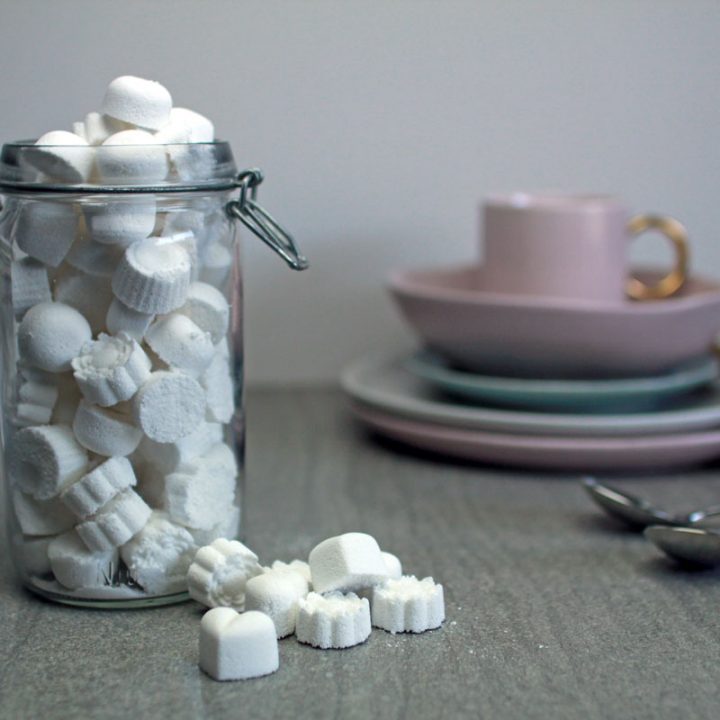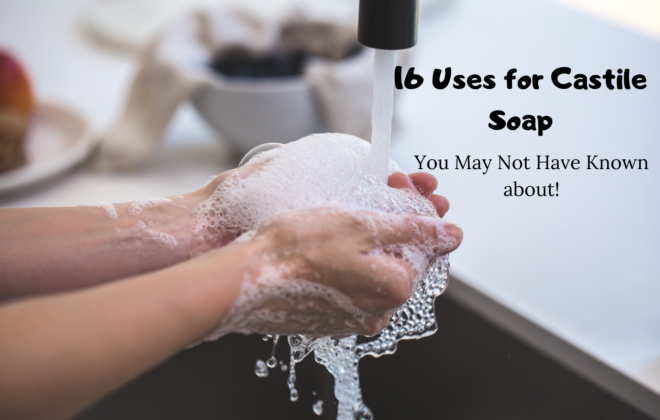DIY Dishwasher Detergent
This DIY Dishwasher detergent is so simple and easy to make and be left as a powder, or made into tablets, whatever works best for you! Commercial Dishwasher products contain all sorts of toxic chemicals, small amounts of these chemicals remain on your dishes, and then these are inadvertently consumed when you cook in or eat off those dishes. Yuck!
I have tried many DIY dishwasher tablets recipes since I have converted to a low tox Lifestyle and most have been extremely disappointing. But after neatly 2 years working on this recipe (yep seriously!) I think I have finally cracked it.
What Ingredients are in This DIY Dishwasher Detergent
Washing Soda
Washing soda (Sodium Carbonate) is used in these DIY dishwasher tablets as it is a super water softener and raises the pH of the cleaning water providing a more effective clean. Washing soda is also effective at cutting through grease and oil and descaling deposits in the dishwasher.

Citric Acid
Citric acid keeps hardwater deposits suspended in the wash water so they don’t settle on anything. It can also be used in the rinse compartment. The only catch with citric acid is that it neutralises the washing soda!! The trick is to not add too much citric so you don’t neutralise all the washing soda and hence reduce the cleaning power of your dishwashing tablets. A general rule is to have a maximum 4:1 washing soda to citric ratio.
Oxygen Bleach
Oxygen Bleach (Sodium Percarbonate) breaks down in the presence of water into washing soda and hydrogen peroxide. The washing soda adds more water softening power. Whilst the hydrogen peroxide disinfects, sanitises and removes stains from dishes.
Essential Oils
Essential oils are optional but can contribute to the effectiveness of your DIY dishwasher tablets. They can help to cut through grease and grime, provide anti-bacterial action and most obviously provide a beautifully fresh fragrance. Some essential oils that I think work particularly well in DIY dishwasher tablets are citrus oils like lemon and lime and thieves.

What’s not in This DIY Dishwasher Detergent
There is no Borax, salt, or Baking Powder in this DIY dishwasher detergent recipe. But most importantly there are no chemicals such as synthetic fragrances, preservatives, SLS and dyes that can be toxic to both humans and the environment. You can find more information on what is contained in commercial dishwasher detergents here. You can also check out EWG’s ratings for a popular brand’s dishwasher products at their site, some of their products scored as bad as an F.
No Borax
Borax is a controversial ingredient. In the context of DIY dishwasher tablets, it is used for softening the water and raising the PH, however, washing soda is much more effective at both of these. Using washing soda rather than borax will give the final product more cleaning power.
No Salt
Salt is used in other DIY dishwasher recipes for its water softening properties, but again it is not as strong as washing soda. Using washing soda rather than salt will reduce the water spots and get things cleaner. Additionally salt can cause pitting in stainless steel pots and pans, so is best avoided in your DIY dishwasher tablets.
No Sodium Bicarbonate
Sodium bicarbonate, aka bicarb, is only half as strong as washing soda in raising the pH and softening the water. Why use it when you can use a more effective ingredient.
Eco-Friendly and Low Tox
All the ingredients in this dishwasher detergent are both environmentally friendly and safe for you! With only 3 ingredients there is really no reason not to have a go at making your own.
If you love this recipe be sure to check out some of our other Natural DIY Cleaning Recipes to help you kick toxins to the curb and save money!
We Also Have A collection of DIY Personal Care and Beauty Recipes To Nourish Your Body Naturally…


DIY Dishwasher Detergent
This DIY Dishwasher detergent is so simple and easy to make your very own homemade dishwasher tablets or powder
Ingredients
- 2 cups Washing Soda
- 1 cup Oxygen Bleach
- 1/2 cup Citric Acid
- ~40-60 drops Essential Oil (optional)
Instructions
- Combine all the above ingredients well. (I find a thermomix or food processor works best at mixing in essential oils if using, but a whisk will do the job)
- Transfer the powder to moulds and press down firmly.
- Leave to harden for 24-72 hours. In most cases the humidity in the air is enough to harden these tablets, but in some cases when the humidity is really low they remain a powder. If this occurs you can try spraying with some water, or just use as a powder. If you choose you can add a small amount of water during the mixing stage although it is generally not required.
- Transfer to an airtight container for storage
- Combine all the above ingredients well. (I find a thermomix or food processor works best at mixing in essential oils if using, but a whisk will do the job
- Transfer the powder to a container (or leave in the bowl), leave uncovered and place in a safe location away from inquisitive kiddos
- Leave exposed to the atmosphere for 24-72 hours, mixing up the powder periodically with a whisk or spoon. It will absorb some moisture from the air and go a bit lumpy, but doing this will ensure that it doesn't clump together and harden in storage.
- Transfer to an airtight container for storage
To Make Tablets
To Make Powder
Notes
- Citric acid tends to absorb moisture from the air. This is how the tablets harden without added moisture and why powders containing citric acid ted to clump together.
- Makes 50-80 tablets depending on the size of your mould. I use mostly chocolate moulds and end up with around 80 tablets weighing around 8g each.

How To Use
Depending on the size of your finished tablet and how dirty your dishes









Hi, do these tablets work in very hard water areas? Thanks
Hi Vanessa,
Great question. We put your question to the members in our Facebook group and someone with hard water in their area confirmed that this recipe works well for them. They said they tend to keep it as a powder so they can add a bit extra when needed.
Can’t wait to try it! Now can you just tell me what to do with all the other recipes with baking soda and salt that I’ve tried? Seriously! They leave my dishes filmy and I hate to waste them by throwing away all those ingredients. after two years of experimenting I’m sure you’ve made a few bad batches.
HI Ginny, did you manage to find something to do with all those recipes? how did you go with ours?
WOW!! I did not expect to be so impressed with this recipe! I’ve never seen my dishes so literally squeaky clean and shiny. Apparently store bought tablets left a film. I’m thinking the washing soda does a good job softening our hard water. Thank you for sharing your recipe!
From Canada
Hi Erika. So glad you love it! We do too. How lovely our recipe is being used all the way in Canada x
Hi there, if not using any essential oils, is it still necessary to ‘air out’ the powder or can I use it straight away?
Thanks!
Yes. The citric acid sucks water from the atmosphere, if you pop it into a container straight away it might solidify into a big clump. however some of our followers do skip this step with no dramas.
I live in low humidity place. Does mixing in water reduce the cleaning power? As in will the water react to some ingredients and make it less effective? Cuz I tried spraying water on top of the mould and it fizzes a little but it still wasn’t enough to harden it.
Hi Jacqui,
We don’t find mixing water reduces the cleaning power, however, we have found in extremely dry, low humidity conditions it is near on impossible getting the tablets to harden. Have you tried just keeping it as a powder and using 1/2 to 1 tbsp per load? This is what we do, and we save on the time and mess of making the tablets.
Hi, I have used this recipe but I get a powdery residue and it’s doesn’t remove tea stains in mugs (I have to hand wash first before putting them in the dishwasher). I’ve tried (in several batches) increasing the washing soda, increasing the citric acid and using less of the product but still have the problem. Is it the dishwashing powder or is it the rinse aid that would cause this? I’d love your help! Thank you
Hi Virginia,
Try using less powder, we find a powdery residue generally means too much product is being used. Using a rinse aid also helps if you don’t use one, they help keep solids suspended during the rinse cycle, reducing deposits on your clean dishes. You can find a recipe for a citric acid one on our website.
Tea stains can be a tricky one, Most toxic dishwashing products also leave these behind. you can try filling them up with a solution of oxygen bleach or washing soda and let sit for an hour or two, and that should sort them out.
Thank you so much. I am going to try making it. Just started using dishwasher and I am getting really into now. I love the dishwasher. lol
Could I use lemon juice to make the pods? Thanks, Kitty
Hi Kitty,
It is probably best not to as it might encourage the growth of mould.
I’m not sure why, but I put washing soda, oxygen bleach and citric acid in and it foamed up and got very very hot.
Hi Katie,
Were all the ingredients dry?
Jenny
Hi, I haven’t tried the recipe yet and I was wondering if the essential oil ever leave any smell on dishes especially on plastic?
I’ve been searching for homemade dishwashing tablets that allows me to wash and clean the dishes without leaving any smell/ soap taste. It’d be great to know that this is the recipe I’m searching for 🙂
Hi Maggie,
We havent noticed any small or taste left on the dishes with this recipe. If you are concerned you can leave the essential oils out, they are not an essential ingredient in any way. I never bother to add them personally.
Cheers
Jenny